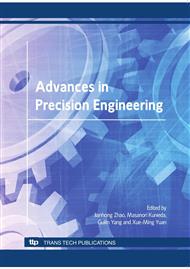p.690
p.695
p.700
p.705
p.710
p.715
p.720
p.725
p.734
Flexible Transparent Conducting Film by Hot Embossing
Abstract:
Flexible transparent conducting (TC) film is a key element as the transparent electrode of the flexible electronics such as touch screen, solar cell, display or lighting. Current commercial flexible sputtered ITO films have shown some limitations; high sheet resistance (> 10 ohm/sq), deterioration of ITO film during repeatedly bending, indium scarce, and expensive fabrication process (sputtering). In this report, a new simple and cheap process to make such flexible TC film by using hot embossing and forming micro metal mesh underneath transparent conducting layer is proposed. This simple process has yielded a promising result with sheet resistance as low as 4 ohm/sq and the light transmission of 68% (@550nm). Future improvement on light transmission is discussed.
Info:
Periodical:
Pages:
710-714
Citation:
Online since:
September 2010
Authors:
Price:
Сopyright:
© 2010 Trans Tech Publications Ltd. All Rights Reserved
Share:
Citation:


